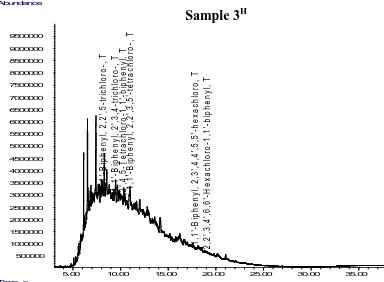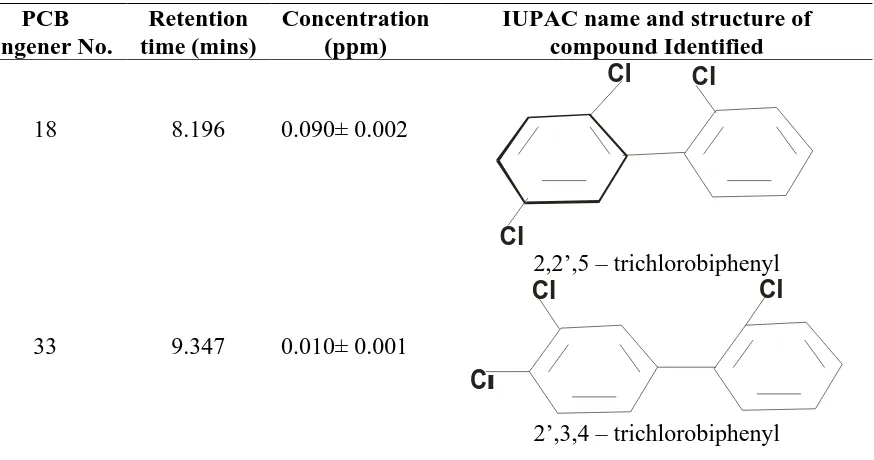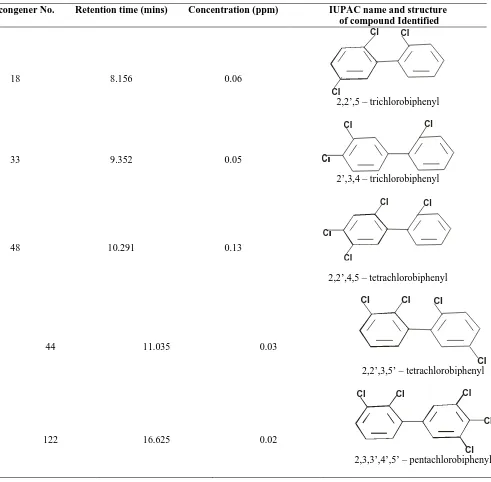ASSESSMENT OF THE LEVELS OF PERSISTENT
ORGANIC POLLUTANTS (POLYCHLORINATED
BIPHENYLS) IN EFFLUENTS FROM PETROLEUM
PRODUCTS TANK FARM IN CALABAR JETTY,
CROSS RIVER STATE, NIGERIA
Neji, P.A.,* Anozie, R. C.** and Vincent, T.O.**
*
Department of Chemical Science, Cross River University of Technology, Calabar, Nigeria
**
Department of Pure and Applied Chemistry, University of Calabar, Calabar, Nigeria
DOI: 10.29322/IJSRP.8.4.2018.p7658
http://dx.doi.org/10.29322/IJSRP.8.4.2018.p7658
ABSTRACT: This study has its objectives of assessing the levels of polychlorinated biphenyls in five soil samples collected from the effluent channel of petroleum product tank farm in Calabar Jetty, Cross River State. The five soil samples were subjected to analytical procedure by extracting with n-hexane/acetone mixture volume (1:1). The extracts were distilled at 56oC to remove acetone and the residue from each extract was mixed with 20ml of distilled water and separated with a separatory funnel. The hexane phase was collected from each sample and the clean-up process was carried out using florisil column prepared according to slurry packing technique (1cm x 25cm glass column containing 5.0g florisil, 60-100mesh, conditioning for 4hrs at 250oC) then deactivated with 5% water by weight, with a layer of anhydrous sodium sulphate on top to remove interferences before they were analyzed and quantified using GC-ECD/MS instrumentation. The results revealed presence of PCBs in all the samples except the control sample. The chromatograms identified some PCB congener numbers present in the samples and they are: PCB 18, PCB 33, PCB 44, PCB 48, PCB 122, PCB 145, PCB 150, and PCB 167. The results indicated the various concentrations of PCBs present and levels of PCBs were at toxic limits which could be detrimental to the environment and human health. Thus suggestions were made on the best way to dispose these effluents.
Keywords - Polychlorinated biphenyl, Congener, Effluents, Tank farm, Jetty.
1.0 INTRODUCTION
Polychlorinated biphenyls (PCBs) are compounds containing some chlorine atoms attached at different positions of the biphenyls molecule. Biphenyls molecule is a molecule made of two benzene compounds joined together by carbon to carbon single bond. These Polychlorinated biphenyls do not occur in nature, they are introduced into the environment by anthropogenic activities. PCBs have been sold out to different countries with many trade names such as: Aroclor,
Chlorextol,Clophen,Phenoclor, Fenclor, Kanechlor, Pyranol, Sovol etc.[1]
PCBs are introduced into the environment through leakages from most electrical equipment containing capacitors, hydraulic oil, petroleum product effluents, transformers and liquid heat exchangers or coolants. The PCBs when given off goes into the air, water, sediment and soil. It was eventually banned in 1979 by United States Stockholm convention and was classified among the persistent organic pollutants in 2001.[2] Some electrical equipment at elevated temperature emits PCBs into the atmosphere which goes into the food chain thereby affecting the fishes and other aquatic organisms in the river. These fishes when consumed by man causes ailments such as birth defects.[3]They affect the hormone system in man especially the sperm count and causes cancer in animals.[4]
In the phase of all these, it is pertinent that these effluents from the petroleum tank farm in Calabar Jetty identified to be toxic should be properly treated using the most effective method of destruction to reduced its toxicity level before been discharged to the environment.
2.0 MATERIALS AND METHODS
2.1 Sample Collection
ISSN 2250-3153
FIGURE 1: Sample site
2.2 Sample preparation
The samples were air dried for a period of two months and all foreign materials such as leaves, sticks and stones were removed in the process. The samples were then crushed with pestle and mortar, sieved to a fine powder using a sieve with aperture 100micron.
2.3 Extraction process
100g of each sample was weighed into a sample bottle and 100ml mixture of n-hexane: acetone, 1:1 (v/v) was added for batch extraction. The mixture was allowed to stay for 24hrs after which decantation was carried out. The liquid was filtered into a round bottom flask and was distilled to a temperature of 56oC to remove all acetone present. The residue was collected and poured into a separating funnel. 20ml of distilled water was poured into the separating funnel. The mixture was shaken thoroughly and allowed to settle in phases (Hexane/ Water phase). The hexane phase was collected in vial bottles for gas chromatography and mass spectrometry analyses. The procedure was repeated four times for the five samples.
2.4 Gas chromatography clean-up process
The samples were allowed to evaporate to dryness in air then dissolved in 1-2ml of hexane. The elution was done with 50ml n-hexane through florisil column prepared according to slurry packing technique (1cm x 25cm glass containing 5.0g florisil, 60-100mesh, conditioning for 4hrs at 250oC) then deactivated with 5% water by weight, with a layer of anhydrous sodium sulphate on top, and rinsed with 50ml n-hexane before use. The fraction obtained was then used for G-C analysis.[5]
2.5 GC – ECD/ MASS SPECTROMETRY (Hewlett Packard 6890).
The GC equipment with Ni electron capture detector (ECD) having DB – XLB fused silica capillary column(60m x 0.25m, 0.25um thickness) at 50KPa pressure was used. Helium gas of very high purity was used as the carrier gas at 54.4ml/min. Following the injection, the GC temperature was initially set at 60oC for 1min,then temperature was programmed to 140oC at 10oC/min, at 0.9oC/min to 220oC/min and at 5oC/min to 290oC (hold for 15mins). Identification of the PCB ion peaks were based on the retention time relative to the Internal Standard
and their relative abundances of the ions monitored. The mass spectrometry connected to the GC gives the qualification by comparing the integrated ions current response of the target ions to those of the internal standard and their relative abundances of the ions monitored.
3.0 RESULTS
The five samples show variation in temperature, pH, conductivity and appearance as seen in Table 1, the samples
except the control sample 5H have the presence of
[image:2.595.307.488.236.369.2]polychlorinated biphenyl compounds with various retention time and concentration as shown in Figures 1-5 and Tables 2-6.
Figure 1: GC/MS chromatogram of sample 1H
Figure 2: GC/MS Chromatogram of sample 2H
Figure 3: GC/MS chromatogram of sample 3H
5.00 10.00 15.00 20.00 25.00 30.00 35.00 500000 1000000 1500000 2000000 2500000 3000000 3500000 4000000 4500000 Time--> Abundance
TIC: 1h aNOZIE.D\data.ms
2, 3, 3' ,4' ,5' - P ent a c hl or o-1, 1' -bi pheny l, T 1, 1' -B ipheny l, 2, 2 ', 3, 5' -t et rac hl or o-, T 2, 2' ,4, 5-T et rac hl o ro-1, 1' -bi pheny l, T 1, 1' -B ipheny l, 2' ,3 ,4-tr ic hl or o-, T 1, 1' -B ipheny l, 2, 2 ', 5-tr ic hl or o-, T
5.00 10.00 15.00 20.00 25.00 30.00 35.00 500000 1000000 1500000 2000000 2500000 3000000 3500000 4000000 4500000 Time--> Abundance
TIC: 2h ANOZIE.D\data.ms
1, 1' -B ipheny l, 2' ,3, 4-tr ic hl or o-, T 1, 1' -B ipheny l, 2, 2' ,5-tr ic hl or o-, T
5.00 10.00 15.00 20.00 25.00 30.00 35.00
500000 1000000 1500000 2000000 2500000 3000000 3500000 4000000 4500000 5000000 5500000 6000000 6500000 7000000 7500000 8000000 8500000 9000000 9500000 Time--> Abundance TIC: 3A.D\data.ms 2, 2 ', 3 ,4 ', 6 ,6' -H ex ac hl o ro -1 ,1' -bi ph en y l, T 1 ,1' -B iph en y l, 2 ,3' ,4, 4' ,5, 5 '-h ex ac hl or o, T 1 ,1' -B iph en y l, 2 ,2' ,3, 5' -t et ra c h lor o-, T 2, 2 ', 4 ,5 -T et rac hl o ro -1 ,1' -bi ph en y l, T 1, 1 '-B ip he ny l, 2' ,3, 4 -t ri c h lo ro-, T 1 ,1' -B iph en y l, 2 ,2' ,5-tr ic hl or o -, T
Sample 1H
Sample 2H
[image:2.595.307.487.406.528.2] [image:2.595.306.498.583.724.2]Figure 4: GC/MS chromatogram of sample 4H Figure 5: GC/MS \Chromatogram of control sample 5H
Table 1: Physical properties of soil samples from company Hamdza(H)
S/No Sample Name Temperature (oC) pH Conductivity(µScm-1) Appearance
1 Sample 1H 27.9± 0.10 7.79± 0.05 1.10± 0.06 Black
2 Sample 2H 27.2± 0.10 7.79± 0.03 0.25± 0.01 Black
3 Sample 3H 27.7± 0.20 7.53± 0.03 1.46± 0.10 Black
4 Sample 4H 27.3± 0.10 7.72± 0.01 0.92± 0.07 Black
5 Sample 5H 27.9± 0.10 7.69± 0.02 2.26± 0.10 Brown
Table 2: GC-MS identified compounds in sample 2H
PCB
congener No.
Retention
time (mins)
Concentration
(ppm)
IUPAC name and structure of
compound Identified
18
8.196
0.090± 0.002
Cl
Cl
Cl
2,2’,5 – trichlorobiphenyl
33
9.347
0.010± 0.001
2’,3,4 – trichlorobiphenyl
5.00 10.00 15.00 20.00 25.00 30.00 35.00
500000 1000000 1500000 2000000 2500000 3000000 3500000 4000000 4500000 5000000 5500000 6000000 6500000 7000000 7500000 8000000 8500000 9000000 9500000 Time--> Abundance TIC: 4A.D\data.ms 2, 2' ,3, 4' ,6 ,6 '-H ex ac h lo ro-1, 1' -bi phe ny l, T 1, 1' -B ip hen y l, 2, 3' ,4, 4' ,5 ,5 '-he x ac hl or o , T 2, 2' ,3, 4, 6, 6' -H ex ac hl or o -1 ,1 '-bi ph eny l, T 1, 1' -B ip hen y l, 2, 2' ,3, 5' -t et ra c hl or o-, T 2, 2' ,4, 5-T et rac hl or o-1, 1' -b ip heny l, T 1, 1' -B ip hen y l, 2' ,3, 4-tr ic hl or o-, T 1, 1' -B ip hen y l, 2, 2' ,5-tr ic hl or o-, T
5.00 10.00 15.00 20.00 25.00 30.00 35.00 100000 200000 300000 400000 500000 600000 700000 800000 900000 Time--> Abundance
TIC: 3 aNOZIE.D\data.ms
C
lCl
Cl
Sample 4H
[image:3.595.50.487.382.612.2]ISSN 2250-3153
Table 3:GC-MS identified compounds in sample1H
PCB congener No. Retention time (mins) Concentration (ppm) IUPAC name and structure of compound Identified
18 8.156 0.06
Cl
Cl
Cl
2,2’,5 – trichlorobiphenyl
33 9.352 0.05
2’,3,4 – trichlorobiphenyl
48 10.291 0.13
Cl
Cl
Cl Cl
2,2’,4,5 – tetrachlorobiphenyl
44 11.035 0.03
Cl
Cl Cl
Cl
2,2’,3,5’ – tetrachlorobiphenyl
122 16.625 0.02
[image:4.595.44.558.75.564.2]2,3,3’,4’,5’ – pentachlorobiphenyl
Table 4: GC-MS results in sample 5H
PCB congener No.
Retention time (mins)
Concentration (ppm) IUPAC name and structure of compound identified
ND ND ND ND
ND: Not Detected.
Table 5:GC-MS identified compounds in Sample 3H
Cl
Cl Cl
Cl
Cl
Cl Cl
www.ijsrp.org
Table 6:GC-MS identified compounds in sample 4H
PCB Congener
No.
Retention time (mins)
Concentration (ppm)
IUPAC name and structure of compound identified PCB congener
No.
Retention time (mins)
Concentration (ppm) IUPAC name and structure of compound identified
18 8.180 0.610±0.002
Cl
Cl
Cl
2,2’,5 – trichlorobiphenyl
33 9.393 0.120± 0.006
2’,3,4 – trichlorobiphenyl
48 10.268 0.100± 0.004
C
lCl
Cl
Cl
2,2’,4,5 – tetrachlorobiphenyl
44 11.018 0.300± 0.004
Cl
Cl Cl
Cl
2,2’3,5’ – tetrachlorobiphenyl
167 17.758 0.020± 0.001
2,3’,4,4’,5,5’ – hexachlorobiphenyl
150 19.063 0.020± 0.001
2,2’,3,4’,6,6’ – hexachlorobiphenyl
C
lCl
Cl
Cl
Cl
Cl
Cl
Cl
Cl
Cl
Cl Cl
Cl Cl
ISSN 2250-3153
http://dx.doi.org/10.29322/IJSRP.8.4.2018.p7658 www.ijsrp.org
18 8.179 0.32
Cl
Cl
Cl
2,2’,5 – trichlorobiphenyl
33 9.318 0.21
2’,3,4 – trichlorobiphenyl
48 10.251 0.12
Cl
Cl
Cl Cl
2,2’,4,5 – tetrachlorobiphenyl
44 11.046 0.23
Cl
Cl Cl
Cl
2,2’,3,5’ – tetrachlorobiphenyl
145 16.425 0.02
Cl
Cl
Cl Cl
Cl
Cl
2,2’,3,4,6,6’ – hexachlorobiphenyl
167 17.695 0.03
150 18.977 0.03
2,2’,3,4’,6,6’ hexachlorobiphenyl 4.0 DISCUSSION
The parameters in Table 1 show that the temperature of the five samples were between the range 27.2± 0.10oC to 27.9 ± 0.10oC with a mean temperature of 27.55 ± 0.10oC. These temperature values were relatively the same as the room temperature on the day of sampling. The pH values tend
slightly to alkalinity and were between the range 7.53 ± 0.03 to 7.79 ± 0.05,this same range was reported by Moret[6] in sediments from Porto Marghera area. The electrical conductivity of four samples were very low except for control sample 5 which has a high value of 2.96 ± 0.10µScm-1. These
C
lCl Cl
Cl
Cl Cl
Cl Cl
Cl
C
l
Cl
Cl
Cl
Cl
Cl
www.ijsrp.org
low values in electrical conductivity validate one of the physical properties of PCBs having low electrical conductivity in nature. The dark colour observed may be as a result of the types of effluent discharge and also the presence of PCB, since the control sample was lighter in colour. GC-MS chromatogram in figure1-figure4 and table 2,3,5,and 6 results indicated the presence of PCB 18, PCB33, PCB 44, PCB 48, PCB 122, PCB 145, PCB 150 and PCB 167. In all the samples
there were PCBs present except for sample 5H.The
chromatogram for the control sample in figure 5 and result in table 4 has no identified PCB peak present in the sample .The identified PCBs have ortho-substituted congeners which had been reported by Simon to cause neurotoxic and immunotoxic diseases while the di-ortho substituted congeners, PCB 145 and PCB 150 interfere with intracellular signal transduction, and also leads to neurotoxicity.[7]It is also reported by Chauhau that ortho-substituted PCBs can disrupt the thyroid hormone movement by binding to transthyretin.[8]Other symptoms of PCBs include skin and ocular lesions, reduction in the levels of immune system, women affected with high concentration of PCBs also experience problem during their menstrual period.[9][10][11]Pregnant women exposed to PCBs before delivery gave birth to children with low cognitive ability, and motor sensory problems.[12][13][14]The International Agency for Research on Cancer (IARC) has grouped some PCBs such as
the 3,3’,4,4’,5- pentachlorinated biphenyls as being
carcinogenic to man[15] and this can be compared with the PCB 122 identified in this study. When people are exposed to these toxic PCB compounds, they cause a great retardation and damage in steroid and other reproductive hormone development.[16][17][18]
5.0 CONCLUSION
The congener numbers present in the effluent samples; PCB 18, PCB33, PCB 44, PCB 48, PCB 122, PCB 145, PCB 150 and PCB 167 are toxic to man since the concentration identified is higher compared with 0.0005ppm EPA concentration of PCB limit for water. Proper treatment has to be taken in the disposal of the effluents from Calabar tank farm in Nigeria. Some of these treatment processes include; Incineration at very elevated temperature, proper mixing and extended residence time.[19]PCBs are chemically reduced or degraded toxically by addition of glycols and also organometallic compounds of sodium.[20]Microbial enzymes can also biodegrade soil contaminated with PCBs.[21]It is obvious that these effluents released into the environment in Calabar can be treated by degradation through various means so as to eliminate some of these ailments associated with PCBs, such as birth defect in man and hormonal imbalance and cancer in animals.[3][4]
REFERENCES
[1]Helsinki Commission, (2007). Voluntary report on implementation of the programme of work on marine and costal biological diversity. Baltic Marine Environment Protection Commission,1-101.
[2] Porta, M., Zumeta, E. (2002) Implementing the stockhelin Treaty on persistent Organic Pollutants Occupational and Environmental Medicines 59: 651-652
[3] Environmental Health (2009) Department of Public Health Division of Environmental Health.
[4] ATSDR (2000). Toxicological profile for Polychlorinated Biphenyls. Agency for Toxic Substances and Disease Registry.Atlanta,GA. USA, Department of Heaith and Human Services, Public Health Services.
[5] US EPA, 2010, Method 1668C; Chlorinated biphenyl cogeners in water, soil, sediments, biosolids and tissue,Environmental Protection Agency 16(3);110-115.
[6]Moret I. Piazza R. Benedetti M. GamberooA.Barbante C.&Cescon P. (2001) Determination of Polychlorobiphenyls in Venice Lagoon sediments.Chemosphere 43,559 - 565.
[7] Simon, Ted; Britt, Janice K.; James, Robert C. (2007). "Development of a neurotoxic equivalence scheme of relative potency for assessing the risk of PCB mixtures".Regulatory Toxicology and Pharmacology.48 (2): 148–170.
[8] Chauhan, K; Kodavanti, PR; McKinney, JD (2000). "Assessing the Role of ortho-Substitution on Polychlorinated Biphenyl Binding to Transthyretin, a Thyroxine Transport Protein". Toxicology and Applied Pharmacology. 162
(1): 10–21.
[9]Aoki, Y (2001). "Polychlorinated Biphenyls, PolychloronatedDibenzo-p-dioxins, and Polychlorinated Dibenzofurans as Endocrine Disrupters—What We Have Learned from Yusho Disease".Environmental Research.86 (1): 2–11
[10]Disease ID 8326 at NIH's Office of Rare Diseases
[11]"PCBBabyStudiesPart2".June2016.www.foxriverwatch.com Retrieved 9 [12]Jacobson, Joseph L.; Jacobson, Sandra W., ( 1996). "Intellectual Impairment in Children Exposed to Polychlorinated Biphenyls in Utero". New England Journal of Medicine.335 (11): 783–789.
[13]"Public Health Statement for PCBs". Retrieved 9 June 2016.
[14].Stewart, Paul; Reihman, Jacqueline; Lonky, Edward; Darvill, T.; Pagano, James (2000). "Prenatal PCB exposure and neonatal behavioral assessment scale (NBAS) performance". Neurotoxicology and Teratology.22 (1): 21–29.
[15] IARC (2009) ,International Agency for Research on Cancer (IARC Monographs on the Evaluation of Carcinogenic Risks to Humans, Vol. 100) [summary in Baan R et al.. A review of human carcinogens—Part F: Chemical agents and related occupations. The Lancet Oncology, 10(12):1143–1144. [16] WHO (2002). Polychlorinated dibenzodioxins, polychlorinated dibenzofurans, and coplanar polychlorinated biphenyls. In: Safety evaluation of certain food additives and contaminants. Geneva, World Health Organization (WHO Food Additives Series, No. 48.
[17] IPCS (2003). Polychlorinated biphenyls: Human health aspects. Geneva, World Health Organization, International Programme on Chemical Safety (Concise International Chemical Assessment Document 55
[18] IPCS (1993). Polychlorinated biphenyls and terphenyls, 2nd ed. Geneva, World Health Organization, International Programme on Chemical Safety (Environmental Health Criteria 140.
[19] UNEP (2004). Inventory of world-wide PCB destruction capacity. Geneva, United Nations Environment Programme, UNEP Chemicals. [20]Woods, Sandra L.; Trobaugh, Darin J.; Carter, Kim J. (1999). "Polychlorinated Biphenyl Reductive Dechlorination by Vitamin B12s: Thermodynamics and Regiospecificity". Environmental Science & Technology.33 (6): 857–863.
[21] De Windt .W, Aelterman .P, Verstraete .W, (2005). "Bioreductive deposition of palladium (0) nanoparticles on Shewanellaoneidensis with catalytic activity towards reductive dechlorination of polychlorinated biphenyls.".Environmental Microbiology.7 (3): 314–325
AUTHORS
ISSN 2250-3153
http://dx.doi.org/10.29322/IJSRP.8.4.2018.p7658 www.ijsrp.org
Second Author – Anozie, Remigius Chukwudi, (M.Sc.), University of Calabar, Calabar, Nigeria
Third Author – Vincent, TemitopeOlatunde, (M.Sc), University of Calabar, Calabar, Nigeria.



